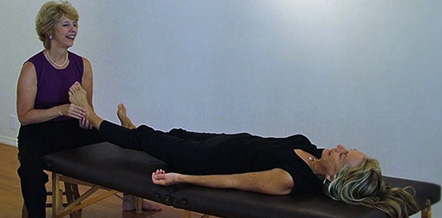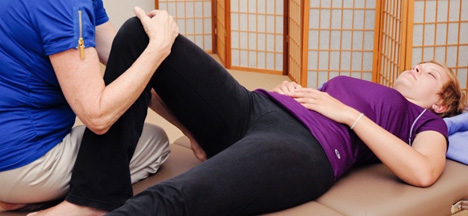Basic to the Method is shifting from ‘fixing’ or ‘correcting’ to ‘learning’.
1. ‘Learning’ is sensing and discerning subtle differences
In order to heighten your ability to sense, The Feldenkrais Method® removes you from the action and out of gravity so you can feel your full weight safely supported by a chair, table, or floor allowing your neuromuscular system to quiet holding patterns.
You learn to sense differences between:
| Moving with tightly held muscles | Moving with less muscle tone |
| Using 10 lbs. of effort | Using 1 lb. of effort |
| Mind and body disconnected | Feeling Embodied – fully connected Mind and Body |
| Moving an arm to reach w/o awareness | Moving an arm from your pelvis – heightened awareness |
| Unaware of shoulders in walking | Aware of shoulders as you walk |
| Unaware of any movement in torso as you breath | Noticing movements while breathing |
2. Reversibility: Anything learned can be un-learned.
Learned habits are learned strategies. They are not good or bad. However, a habitual pattern is only one option. With only one way the experience is  limiting. The more you can create and experience the many options that are available, the more choices you will notice, the more possibilities you’ll have.
limiting. The more you can create and experience the many options that are available, the more choices you will notice, the more possibilities you’ll have.
Limitations are viewed as faulty ‘learned’ strategies. Most habits learned can be unlearned with awareness if we can notice what we are doing.
Reverse movements. Reverse thinking.
3. Your Skeleton is the CORE for balance and movement
The Feldenkrais Method® takes you out of the action, out of gravity’s force, where habitual patterns are maintained. The intention is to return your neuromuscular system to a neutral place, quiet your learned patterns, so you can re-experience yourself moving through the skeleton in a balanced, easy way. This helps establish new actions and behaviors.
4. Look for ‘Dynamic Balance’. Shift ‘posture’ to ‘acture’. Learn to Counterbalance.
Human beings are designed to move, not to be static, as the word ‘posture indicates. Feldenkrais’ idea was to maintain the natural counterbalance so if one slips on something, he/she can respond and stay upright. With fear of falling people tend to take smaller, less rhythmic steps as they stiffen to keep from falling. Most modalities address muscular strength and don’t look at the functional need for maintaining mobility within the stability. The goal is to be ready to respond and react.
5. Expand what is working. Learn how to learn
The limitation is only one small part connected to a whole. Once we optimize the ability to move in areas that are working and have a clear whole ‘image of action’ the ‘limitation’ becomes integrated, as you begin to work again in a ‘clearer’ image of action.
The primary outcome desired from the Feldenkrais Method® is your ability to learn how to learn. Once you engage, benefits happen exponentially. The more you experience a change, the more questions and readiness you have to move to the next step… and then the next step.
6. The process of inquiry: natural curiosity is a key factor for learning.
Unless you have at least three different ways to act or behave that are comfortable and familiar, you don’t really have a choice in your actions. The Method supports re-awakening curiosity so inquiry and problem solving can once more become part of everyday thinking. The goal is to have the confidence that you can create new strategies for any situation.
“The movement is used only for learning. You learn how to do the same thing you know how to do in three different ways.” Moshe Feldenkrais, D..Sc. NYC Worskhop 1980.
7. Metacognition: Awareness to how you do what you do while you are doing it
Knowing what we are doing is the only way to help you get what you want. You can’t make a change in a behavior or action unless you know what and how you are doing what you are doing.
8. Rebuild Maps (connections) in the brain
 A Self Image/Sense of Self is developed through experience of one’s own actions in their world. Body Maps are formed through repeated actions and yet are changeable with different experiences.
A Self Image/Sense of Self is developed through experience of one’s own actions in their world. Body Maps are formed through repeated actions and yet are changeable with different experiences.
“We’re starting to see changes in research that are showing that we do have very plastic brains – meaning that neuronal connections between different cells can sometimes change and we can have new pathways that are wired based on experience. So, there’s an interesting kind of feedback loop where the brain creates mind and then the mind can exert power on the brain and physically change the structure of the brain.”
Professor Santa Maria on Larry King Live, September 17, 2010

